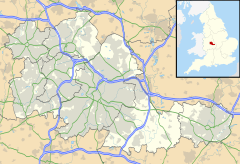Washwood Heath facts for kids
Quick facts for kids Washwood Heath |
|
|---|---|
| Population | 32,921 (2011 Ward) |
| • Density | 80.7 per ha |
| OS grid reference | SP105885 |
| Metropolitan borough | |
| Shire county | |
| Metropolitan county | |
| Region | |
| Country | England |
| Sovereign state | United Kingdom |
| Post town | BIRMINGHAM |
| Postcode district | B8 |
| Dialling code | 0121 |
| Police | West Midlands |
| Fire | West Midlands |
| Ambulance | West Midlands |
| EU Parliament | West Midlands |
| UK Parliament |
|
Washwood Heath is an area in Birmingham, England. It is about two miles north-east of the city centre. This area is a "ward," which is like a local district for voting and local government. Washwood Heath is located between other areas like Nechells, Bordesley Green, Stechford, and Hodge Hill.
Contents
Exploring Washwood Heath's Location
Washwood Heath includes parts of Saltley and Ward End. These two areas cover most of the ward. However, some sections near Nechells and Hodge Hill are simply known as "Washwood Heath."
One of the biggest employers here used to be a railway factory. It was owned by a company called Metro-Cammell (later Alstom). This factory closed down in 2005.
In the 2020s, a new railway depot is being built. This is part of the High Speed 2 (HS2) project. The depot will be used to service and maintain the new high-speed trains.
Who Lives in Washwood Heath?
In 2001, about 27,822 people lived in Washwood Heath. The area is about 5.2 square kilometers. This means there were around 5,335 people living per square kilometer. This is more crowded than the average for Birmingham.
Washwood Heath is a very diverse community. About 57% of the people living there are from different ethnic backgrounds. This is much higher than the average for Birmingham, which was 29.6% at the time. Historically, it was also home to a large Irish community.
Learning and Growing in Washwood Heath
The main school in the area is Washwood Heath Academy. For younger children, there is also a children's centre. These places help kids learn and grow in the community.
Fun Places to Visit
There are several interesting places in and around Washwood Heath:
- In Saltley
- Adderley Park
- Adderley Park railway station
- Wheels Adventure Park
- In Ward End
- Fox & Goose (a pub)
- Ward End Library
- Washwood Heath Christadelphians (a religious group)
- Ward End Park
Images for kids
-
Old LDV factory
The Story of Ward End Works
A big factory called the Ward End Works was built in 1914. It was located between Common Lane and Drews Lane in the Ward End area. The factory covered a huge area of about 65 acres when it was finished. A special building called Bromford House, with a 400-foot-long front, was the main office.
What the Factory Made
At first, the factory was an assembly plant. It made a light car called the Stellite. During World War I, which started in 1914, the factory also made parts for bombs and shells. These were used by soldiers fighting in Europe.
After the war, in 1919, the factory was taken over by another company called Wolseley Motors. Wolseley replaced the small workshops with a large building for assembling cars.
Changes and New Products
In the 1920s, Wolseley faced problems. It was saved when William Morris bought the company. Because of this, all car manufacturing moved to the Ward End Works. In the 1930s, the factory also made engines for the Morris Minor car.
When World War II began in 1939, the factory started making tanks and other military vehicles. In 1941, it also began to produce the Horsa glider, which was a type of aircraft without an engine. During the war, the factory was bombed by German planes in 1941 and 1942. This caused a lot of damage, costing about £500,000.
In 1939, a new factory was built next to the Ward End Works. It was for making metal parts for Morris Motors. After the war, in 1945, this new factory was renamed Nuffield Metal Products. Wolseley car production started again on September 4, 1945.
Later Years and Closure
In 1948, it became more efficient to make new Morris cars at a different factory in Cowley, Oxford. By the 1950s, the Ward End Works mainly made parts for other car brands. These included parts for the Austin-Healey Sprite and some Wolseley cars.
Later, the factory became part of British Leyland. It was then known as the Austin Morris division's Transmission Plant. About 4,400 people worked there.
In 1972, all vehicle production moved to the Common Lane works. In the mid-1980s, there was a fire at the factory, but no other major problems happened.
In 1989, the company changed its name to Leyland-DAF Vans, and then to the LDV Group in 1993. Bromford House became the company's main office. The factory site covered 85 acres. The old factory buildings have since been taken down.
Today, the former factory sites are being redeveloped. They will become the Washwood Heath depot for the new High Speed 2 railway.










